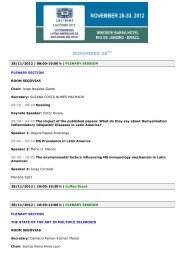Keynote Conference - Interevent
Keynote Conference - Interevent
Keynote Conference - Interevent
You also want an ePaper? Increase the reach of your titles
YUMPU automatically turns print PDFs into web optimized ePapers that Google loves.
L#5<br />
PfCBF transcription factor, a new player for signal transduction<br />
in melatonin-pathways in malaria parasites<br />
Wania Rezende Lima, Miriam Moraes and Célia R. S. Garcia<br />
Departamento de Fisiologia, Instituto de Biociências,<br />
Universidade de São Paulo – São Paulo- Brasil<br />
The signal transduction pathways controlling malaria parasite<br />
development remain largely unexplored. It is now accepted that<br />
Plasmodium senses the environment and exploits calcium and<br />
cAMP signalling pathways to modulate cellular functions. We<br />
want to understand how the molecular machinery for signalling<br />
transduction is put in action in Plasmodium, how second<br />
messengers are generated and if they play a role in the cell<br />
cycle. We have reported that potentially important signaling<br />
molecules from the host cell, the Red Blood Cell (RBCs) such as<br />
ATP modulates Plasmodium falciparum progression within RBCs<br />
through the rise of cytosolic Ca 2+ . We have used a cell-permeant<br />
form of caged-IP3 to investigate the cytosolic IP3 levels under<br />
physiological conditions in infected RBCs co-loaded with both<br />
the cell-permeant caged-IP3 and Fluo4-AM. UV flash photolysis<br />
of caged-IP3 under these conditions elicited a rapid and<br />
transient increase in intracellular Ca 2+ in RBCs infected with P.<br />
falciparum. Thereby providing a direct evidence that a classical<br />
PLC-dependent intracellular Ca 2+ release pathway operates in P.<br />
falciparum infected RBCs. We provided the first direct evidence<br />
that the host hormone melatonin elicits a rise in intracellular IP3<br />
levels in the malaria parasite. We have also found that the<br />
Plasmodium kinase PfPK7 is central in the downstream<br />
mechanism for synchronizing the parasite as a P. falciparum<br />
clone unable to express PfPK7 does not respond to melatonin.<br />
Taken together these data implicate that melatonin activates<br />
Phospholipase C (PLC) to generate IP3 and open ER-localized IP3sensitive<br />
Ca 2+ channels in P. falciparum<br />
In our search for the molecular effectors of second messenger<br />
signaling in P. falciparum we have search for the role of the<br />
PfCBF. The CBF family of transcription factors are involved in<br />
the regulation of cell cycle of many eukaryotic genes. The<br />
molecular and functional characterization of transcription<br />
factors in P. falciparum are yet poorly studied. In order to<br />
determine the protein and mRNA expression levels of intraerythrocytic<br />
PfCBF, western-blot and qRT-PCR were performed.<br />
To localize the CBF protein distribution in the parasite, confocal<br />
microscopy and subcellular fractionation were carried out. The<br />
effect cAMP on PfCBF gene and protein expression during intraerythrocytic<br />
development of the malaria parasites was followed<br />
by qRT-PCR and western blot analysis. PfCBF is expressed<br />
throughout the intra-erythrocytic stages but is greatly<br />
detectable at the schizont stage at both the mRNA and protein<br />
levels.<br />
In conclusion, We suggest that PfCBF may have an integral role<br />
in parasite melatonin responses and the subsequent parasite<br />
development. Then progress in understanding the function of<br />
PfCBF transcription factor in the context of the melatonin<br />
response is likely to provide a better knowledge of the parasite<br />
biology.<br />
L#6<br />
Signal-Adaptor Interactions that Mediate Polarized Sorting in<br />
Neurons<br />
Ginny G. Farías, Loreto Cuitino, Xiaoli Guo, Xuefeng Ren, Rafael<br />
Mattera and Juan S. Bonifacino<br />
Cell Biology and Metabolism Program, Eunice Kennedy Shriver<br />
National Institute of Child Health and Human Development,<br />
National Institutes of Health, Bethesda, Maryland, USA<br />
Neurons are anatomically and functionally polarized cells that<br />
conduct nerve impulses in a vectorial fashion. Impulses are<br />
received by dendrites, propagated through the soma, and<br />
eventually transmitted to other cells by axons. The plasma<br />
membrane of each of these neuronal domains has a distinct<br />
protein composition, but the mechanisms responsible for this<br />
differential distribution of plasma membrane proteins remain<br />
poorly understood. By analogy to other protein sorting<br />
processes, we hypothesized that biosynthetic delivery of<br />
transmembrane proteins to different neuronal domains could<br />
be mediated by interaction of sorting signals in the cargo<br />
proteins with adaptor proteins that are components of protein<br />
coats. Indeed, we found that a tyrosine-based sorting signal in<br />
the cytosolic domain of the transferrin receptor (TfR) mediates<br />
sorting of this protein to the somatodendritic domain in both<br />
hippocampal and cortical neurons. This signal binds to the<br />
mu1A subunit of the clathrin-associated, heterotetrameric<br />
adaptor protein 1 (AP-1) complex. Overexpression of a<br />
dominant-negative mu1A mutant incapable of binding signals,<br />
or RNAi-mediated depletion of another subunit of the AP-1<br />
complex, gamma-adaptin, resulted in missorting of the TfR to<br />
the axon. Various microscopic techniques revealed that sorting<br />
occurs at AP-1-coated areas of the TGN through exclusion of the<br />
TfR from transport carriers bound for the axon. These findings<br />
demonstrate that interactions of sorting signals with AP-1<br />
mediate clathrin-dependent sorting of the TfR and other cargos<br />
to the neuronal somatodendritic domain. Together with recent<br />
observations in other polarized cell types, our findings support<br />
the notion that AP-1 is a global regulator of polarized sorting.<br />
45





